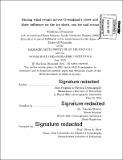| dc.contributor.advisor | Fiamma Straneo. | en_US |
| dc.contributor.author | Oltmanns, Marilena | en_US |
| dc.contributor.other | Woods Hole Oceanographic Institution. | en_US |
| dc.coverage.spatial | n-gl--- | en_US |
| dc.date.accessioned | 2015-09-17T20:22:58Z | |
| dc.date.available | 2015-09-17T20:22:58Z | |
| dc.date.copyright | 2015 | en_US |
| dc.date.issued | 2012 | en_US |
| dc.identifier.uri | http://hdl.handle.net/1721.1/98825 | |
| dc.description | Thesis: Ph. D., Joint Program in Physical Oceanography (Massachusetts Institute of Technology, Department of Earth, Atmospheric, and Planetary Sciences; and the Woods Hole Oceanographic Institution), 2012. | en_US |
| dc.description | Cataloged from PDF version of thesis. | en_US |
| dc.description | Includes bibliographical references (pages 129-143). | en_US |
| dc.description.abstract | In winter, Greenland's coastline adjacent to the subpolar North Atlantic and Nordic Seas is characterized by a large land-sea temperature contrast. Therefore, winds across the coast advect air across a horizontal temperature gradient and can result in significant surface heat fluxes both over the ice sheet (during onshore winds) and over the ocean (during offshore winds). Despite their importance, these winds have not been investigated in detail, and this thesis includes the first comprehensive study of their characteristics, dynamics and impacts. Using an atmospheric reanalysis, observations from local weather stations, and remote sensing data, it is suggested that high-speed wind events across the coast are triggered by the superposition of an upper level potential vorticity anomaly on a stationary topographic Rossby wave over Greenland, and that they intensify through baroclinic instability. Onshore winds across Greenland's coast can result in increased melting, and offshore winds drive large heat losses over major ocean convection sites. Strong offshore winds across the southeast coast are unique over Greenland, because the flow is funneled from the vast ice sheet inland into the narrow valley of Ammassalik at the coast, where it can reach hurricane intensity. In this region, the cold air, which formed over the northern ice sheet, is suddenly released during intense downslope wind events and spills over the Irminger Sea where the cold and strong winds can drive heat fluxes of up to 1000 W m-2, with potential implications for deep water formation. Moreover, the winds advect sea ice away from the coast and out of a major glacial fjord. Simulations of these wind events in Ammassalik with the atmospheric Weather Research and Forecast Model show that mountain wave dynamics contribute to the acceleration of the downslope flow. In order to capture these dynamics, a high model resolution with a detailed topography is needed. The effects of using a different resolution locally in the valley extend far downstream over the Irminger Sea, which has implications for the evolution and distribution of the heat fluxes. | en_US |
| dc.description.statementofresponsibility | by Marilena Oltmanns. | en_US |
| dc.format.extent | 143 pages | en_US |
| dc.language.iso | eng | en_US |
| dc.publisher | Massachusetts Institute of Technology | en_US |
| dc.rights | M.I.T. theses are protected by copyright. They may be viewed from this source for any purpose, but reproduction or distribution in any format is prohibited without written permission. See provided URL for inquiries about permission. | en_US |
| dc.rights.uri | http://dspace.mit.edu/handle/1721.1/7582 | en_US |
| dc.subject | Joint Program in Physical Oceanography. | en_US |
| dc.subject | Earth, Atmospheric, and Planetary Sciences. | en_US |
| dc.subject | Woods Hole Oceanographic Institution. | en_US |
| dc.title | Strong wind events across Greenland's coast and their influence on the ice sheet, sea ice and ocean | en_US |
| dc.type | Thesis | en_US |
| dc.description.degree | Ph. D. | en_US |
| dc.contributor.department | Joint Program in Physical Oceanography | en_US |
| dc.contributor.department | Woods Hole Oceanographic Institution | en_US |
| dc.contributor.department | Massachusetts Institute of Technology. Department of Earth, Atmospheric, and Planetary Sciences | |
| dc.identifier.oclc | 920682116 | en_US |
